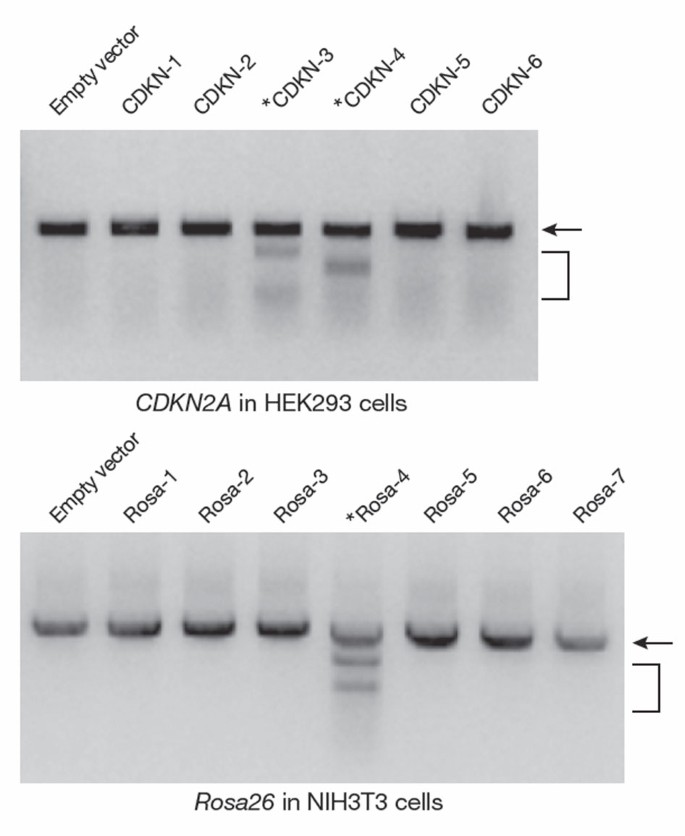Preassembled zinc-finger arrays for rapid construction of ZFNs (original) (raw)
- Correspondence
- Published: 29 December 2010
Nature Methods volume 8, page 7 (2011)Cite this article
- 2114 Accesses
- 73 Citations
- 3 Altmetric
- Metrics details
Subjects
To the Editor:
Since the publication of our Correspondence1 and the reply of Joung et al.2, we improved zinc-finger nuclease (ZFN) modular assembly. ZFNs are artificial restriction enzymes3 composed of tailor-made zinc-finger DNA-binding arrays and the FokI nuclease domain, which can induce site-specific mutations4 and large chromosomal deletions5 in higher eukaryotic cells and organisms.
To reduce the number of ZFNs that need to be synthesized to identify a functional enzyme, we previously compared zinc fingers with equivalent DNA-binding specificity and chose ones that are often found in functional ZFNs4. Based on that analysis, we recommended 37 zinc fingers for use in genome editing4. Here we tested 33 of these fingers, which collectively recognize 39 of 64 three–base-pair subsites (15 GNN subsites and 24 non-GNN subsites, where G is guanine and N is any base; Supplementary Table 1). We prepared a combinatorial library of two-finger modules (Supplementary Methods) consisting of 1,089 (33 × 33 zinc fingers) two-finger arrays, each linked to the FokI nuclease domain. This library allowed us to construct three-finger or four-finger ZFNs in a single subcloning step (Supplementary Fig. 1). Previously, assembling hundreds of ZFNs to target a single gene had taken at least several weeks because up to four repetitive subcloning steps were required to make four-finger ZFNs. With our preassembled two-finger library, preparing several ZFNs to target a gene of interest took only a few days.
We assembled and tested ZFNs to target a human gene and a mouse gene (Fig. 1, Supplementary Fig. 2 and Supplementary Table 2). Of six ZFNs, each targeting different sites at the CDKN2A locus, two ZFNs induced site-specific mutations in human cells. Of seven ZFNs targeting the Gt(ROSA)26Sor (Rosa26) gene, one had genome-editing activity in mouse cells. Thus, the success rate of our improved modular-assembly method was 23% (3/13 ZFNs), in good agreement with the success rate of 24% previously measured by the number of target sites at the human _CCR_5 locus4. In this study, we tested only a single ZFN pair at each target site. Our semi-assembled zinc-finger arrays allow rapid construction of ZFNs in a few days using conventional recombinant DNA technology, and fewer ZFNs need to be synthesized to obtain a functional enzyme.
Figure 1: Targeted genome modifications in human and mouse cells using modularly assembled ZFNs.
Insertion-deletions induced by ZFNs designed for CDKN2A (CDKN-1 to CDKN-6) and for Rosa26 (Rosa-1 to Rosa-7) were detected by digesting PCR amplicons of the respective genes with T7 endonuclease I, which cleaves heteroduplexes but not homoduplexes. Arrow indicates uncut bands, and bracket marks cut bands. Asterisks denote functional ZFNs.
References
- Kim, J.S., Lee, H.J. & Carroll, D. Nat. Methods 7, 91 (2010).
Article CAS Google Scholar - Joung, J.K., Voytas, D.F. & Cathomen, T. Nat. Methods 7, 91–92 (2010).
Article CAS Google Scholar - Kim, Y.G., Cha, J. & Chandrasegaran, S. Proc. Natl. Acad. Sci. 93, 1156–1160 (1996).
Article CAS Google Scholar - Kim, H.J., Lee, H.J., Kim, H., Cho, S.W. & Kim, J.-S. Genome Res. 19, 1279–1288 (2009).
Article CAS Google Scholar - Lee, H.J., Kim E. & Kim, J.-S. Genome Res. 20, 81–89 (2010).
Article CAS Google Scholar
Acknowledgements
J.-S.K. is supported by grants from the National Research Foundation of Korea (2010-0018267) and the Korea Research Institute of Bioscience and Biotechnology Research Initiative Program.
Author information
Author notes
- Seokjoong Kim and Mi Jung Lee: These authors contributed equally to this work.
Authors and Affiliations
- Department of Chemistry, Seoul National University, Seoul, South Korea
Seokjoong Kim, Hyojin Kim & Jin-Soo Kim - ToolGen, Inc., Biotechnology Incubating Center, Seoul National University, Seoul, South Korea.,
Mi Jung Lee & Mijin Kang
Authors
- Seokjoong Kim
You can also search for this author inPubMed Google Scholar - Mi Jung Lee
You can also search for this author inPubMed Google Scholar - Hyojin Kim
You can also search for this author inPubMed Google Scholar - Mijin Kang
You can also search for this author inPubMed Google Scholar - Jin-Soo Kim
You can also search for this author inPubMed Google Scholar
Corresponding author
Correspondence toJin-Soo Kim.
Ethics declarations
Competing interests
M.J.L. and M.K. are employees of ToolGen, Inc. J.-S.K. holds stock in ToolGen, Inc.
Supplementary information
Rights and permissions
About this article
Cite this article
Kim, S., Lee, M., Kim, H. et al. Preassembled zinc-finger arrays for rapid construction of ZFNs.Nat Methods 8, 7 (2011). https://doi.org/10.1038/nmeth0111-7a
- Published: 29 December 2010
- Issue Date: January 2011
- DOI: https://doi.org/10.1038/nmeth0111-7a
This article is cited by
Universal CARs, universal T cells, and universal CAR T cells
- Juanjuan Zhao
- Quande Lin
- Delong Liu
Journal of Hematology & Oncology (2018)
Genome editing comes of age
- Jin-Soo Kim
Nature Protocols (2016)
- Jin-Soo Kim
Genome-editing Technologies for Gene and Cell Therapy
- Morgan L Maeder
- Charles A Gersbach
Molecular Therapy (2016)
